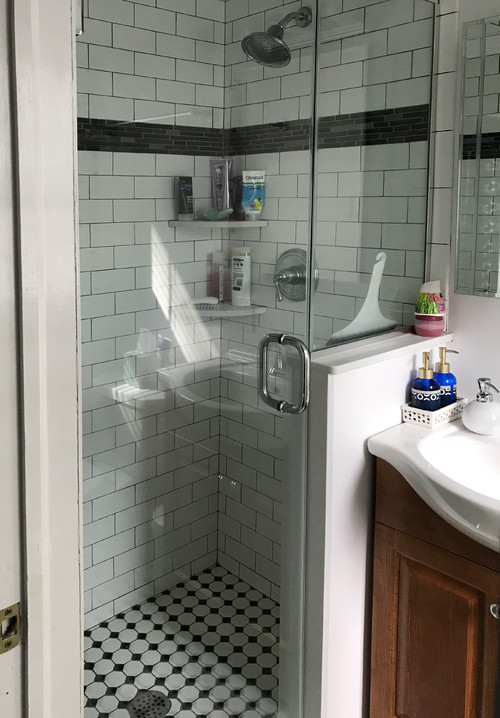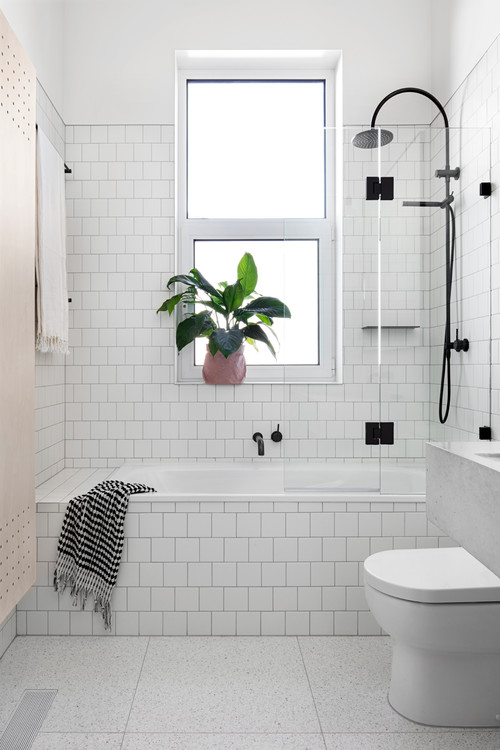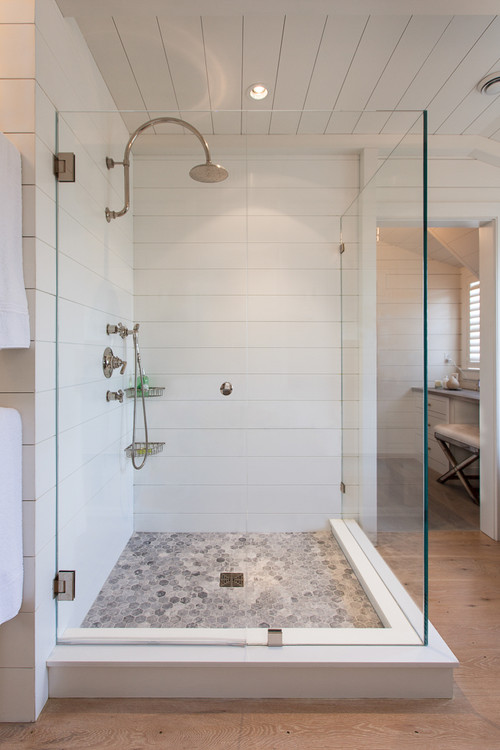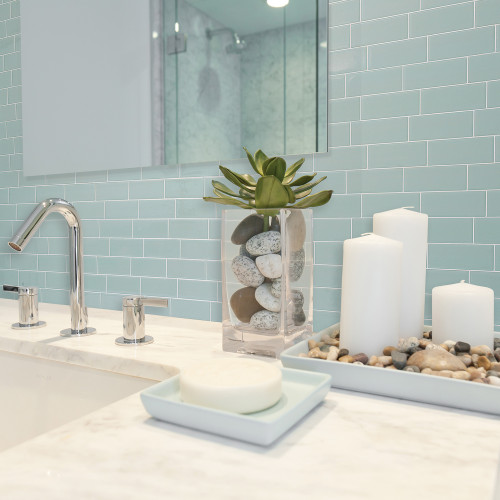
A Big No From Us: Why You Shouldn’t Use Peel and Stick Shower Tiles?
You’ve probably seen an array of peel and stick shower tiles in your quest for a bathroom upgrade. From the sleek look of the subway tiles to the elegance of marble, the variety is endless. Peel and stick subway tiles, with their clean lines and classic look, have an aesthetic appeal. They bring a certain chic vibe to any bathroom, especially when paired with modern fittings.
On the other hand, the marble shower tiles bring a touch of luxury into your space. Their unique patterns and color variations add depth and character to your bathroom. Then there’s the peel and stick marble tile, which may cause look cheaper than you thought. These tiles can seem perfect for creating a feature wall or adding a pop of color to your bathroom, but do they?
Not to forget, peel and stick wood tiles that offer a warm, rustic appeal. They seem to bring in the charm of nature, adding an earthy element to the bathroom. However, they probably won’t last an actual wood look tile and they are not sustainable enough to bring nature to any place.
The Appeal of Peel and Stick Tiles in Bathroom Renovations
Peel and stick shower tiles have gained popularity due to their adaptability, straightforward installation process, and cost-effectiveness in bathroom remodeling projects. This option requires no specialized expertise or professional assistance, enabling individuals to revamp their bathrooms independently. By simply removing the backing and affixing shower wall tiles, it offers a convenient, do-it-yourself approach that doesn’t strain your finances.
However, it’s essential to consider some limitations of peel and stick tiles. While they come in diverse designs, colors, and textures for customization, their adhesive properties may face challenges in wet and humid environments like showers. Over time, exposure to consistent moisture and heat might cause these tiles to lose adhesion or warp, potentially leading to detachment or unsightly appearances. Additionally, their durability might not match that of traditional tiling methods, raising concerns about long-term resilience and maintenance in high-moisture settings.
Despite their initial appeal and ease of application, the adhesive nature of peel and stick tiles might present drawbacks in areas prone to moisture, potentially requiring more frequent replacements or maintenance to uphold their appearance and functionality. However, by using marble subway tiles or any other perfect shower tile options, you can get a chic and quality look.
Can You Use Peel and Stick Tiles in the Shower?
There’s a common misconception that peel and stick tiles aren’t suitable for wet areas like showers. However, this isn’t entirely true. Many peel and stick tiles are designed to be water-resistant, making them an acceptable choice for showers. But, remember, water-resistant doesn’t mean waterproof.
Therefore, while you can use peel and stick tile in the shower, it’s crucial to take some precautions. Firstly, ensure the surface you’re sticking the tiles onto is clean, dry, and smooth. Secondly, it’s recommended to seal the tiles with a waterproof sealer to prevent water from seeping behind them and causing damage. Safety comes first, you can choose actual bathroom mosaic tiles to create a nonslip shower tile sense.
How to Install Peel and Stick Tiles?
Installation of peel and stick tiles is straightforward. Start by cleaning the surface where you plan to install the tiles. Remove any dust, grime, or grease that may prevent the tiles from sticking properly. Then, measure your space and plan your design.
Next, peel off the backing from your tile and position it on your wall or shower floor. Press firmly to ensure the tile adheres properly. Repeat this process until you’ve covered your desired area. Make sure to double-check your alignment as you go to avoid crooked lines.
The Hidden Truth of Peel and Stick Shower Tiles
While their convenience and affordability make peel and stick shower tiles a tempting choice, there are some hidden drawbacks to consider. One of the main concerns is their longevity. Although these bathroom tiles can look fantastic when first installed, they may not stand the test of time, especially in high-moisture environments like bathrooms.
The adhesive used on these tiles can deteriorate over time, causing the tiles to start peeling or moving. Also, their water-resistant nature doesn’t mean they’re immune to water damage. Constant exposure to water can cause these tiles to warp, discolor, or even mold. Hygiene is the most important factor for a bathroom. You can use our natural stone tiles instead of peel and stick ones, we have hygiene tips for natural stone care and maintenance!
Can I Grout Peel and Stick Tile? – Pros and Cons
Grouting peel and stick tile is a topic of much debate. Some homeowners like to grout their peel-and-stick tiles to give them a more traditional tile look and feel. It can also help to waterproof the area between the tiles, reducing the risk of water damage.
On the downside, grouting can be a messy and time-consuming process. It also requires a certain level of skill to get it right. If done incorrectly, it can ruin the look of your tiles and even lead to more water damage. In addition to that, tiling a bathroom can’t be that hard and they last so much longer than a peel and stick option. Take a look at How Hard Is Tiling A Bathroom article and learn more!
How to Remove Peel and Stick Tiles: A Step-By-Step Guide
Removing peel and stick tiles is relatively simple. Start by using a utility knife to score the surface of the tile. Then, use a putty knife or scraper to pry the tile away from the wall. Be careful not to damage the underlying surface.
Removing peel and stick shower tiles can be a cumbersome and labor-intensive task, often more challenging than their initial installation. The adhesive used to attach these tiles can stubbornly adhere to surfaces, making the removal process arduous and time-consuming. It frequently involves scraping or using adhesive removers, which may damage the underlying walls or surfaces, necessitating extensive repairs or refinishing. The residue left behind after removing these tiles can be particularly difficult to eliminate, demanding additional efforts and resources to restore the area to its original state. Overall, the removal of peel and stick shower tiles can be a frustrating and potentially damaging procedure, adding complexities to renovation projects.
Rethinking Your Renovation: Alternatives to Peel and Stick Tiles
Now that you’re aware of the drawbacks of peel and stick shower tiles, you might be rethinking your renovation plans. The good news is there are alternatives to consider. Traditional tiles, like marble tiles, offer durability and a wide range of design options. They may require professional installation, but their longevity can make the investment worthwhile.
Another option is acrylic wall panels. They offer a seamless look, are easy to clean, and are highly resistant to water damage. These panels can be more expensive than peel-and-stick tiles, but their durability makes them a cost-effective solution in the long run.
Making the Right Decision for Your Bathroom Renovation
Peel and stick shower tiles can be a quick and affordable solution for a bathroom makeover. However, their potential issues with longevity and water resistance may make you rethink their use in your renovation. Consider your bathroom’s specific needs, budget, and long-term goals before making a decision. After all, a well-thought-out renovation can enhance your home’s comfort, functionality, and value. At our tile store, we provide you with various selections of shower tile ideas that make you happy with your renovation!










